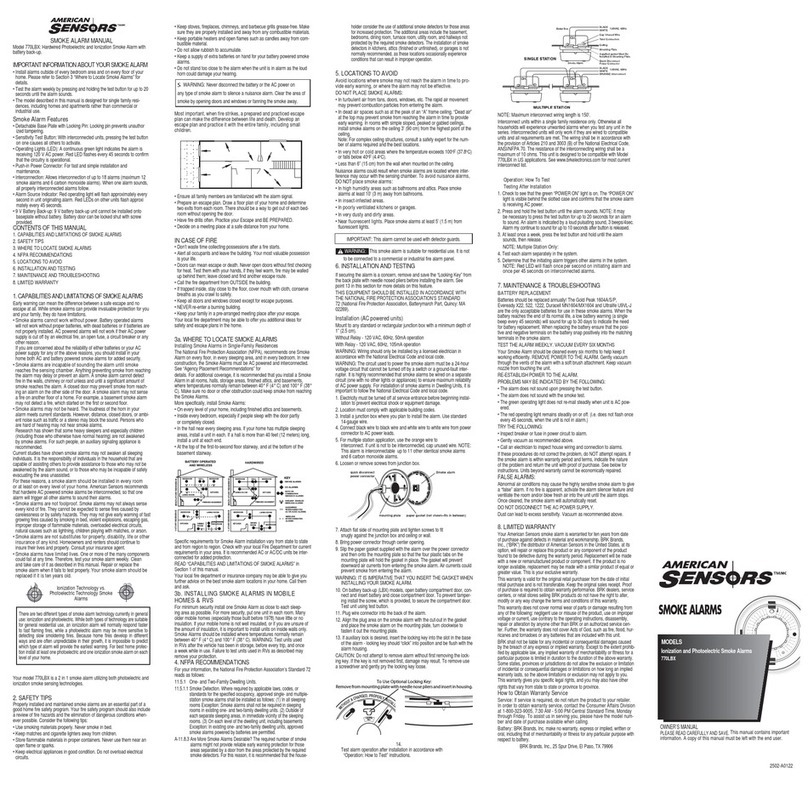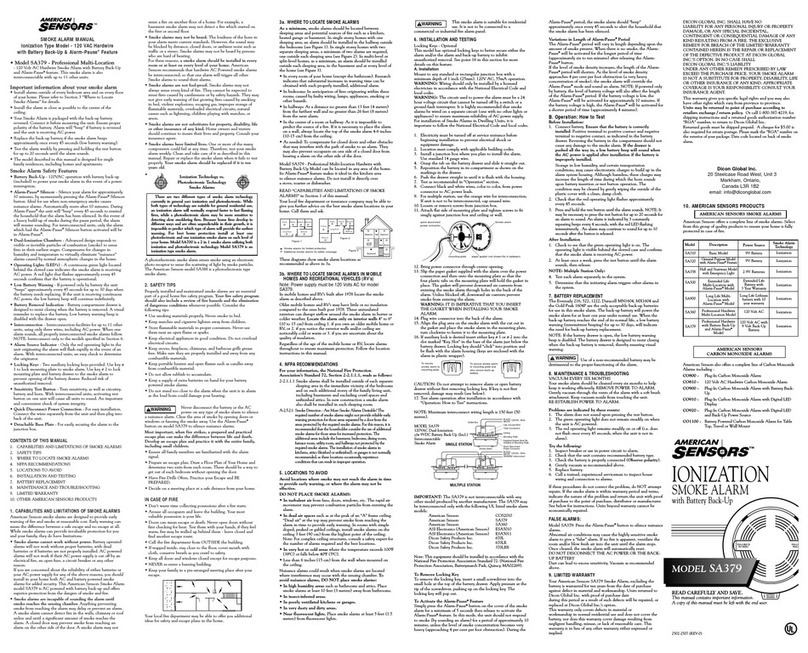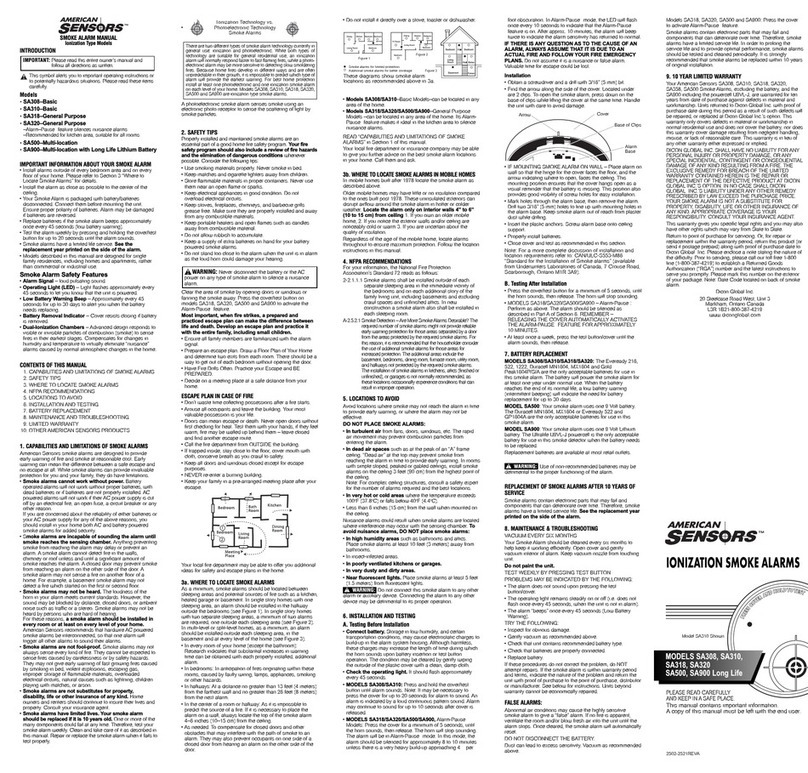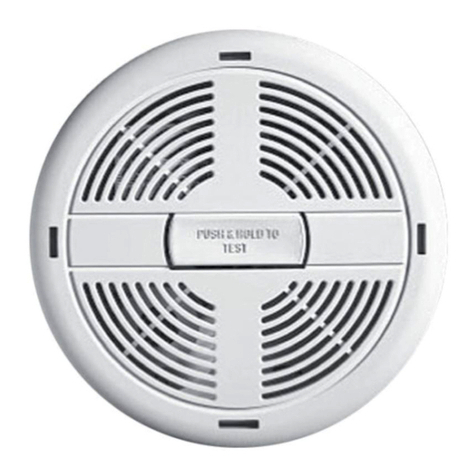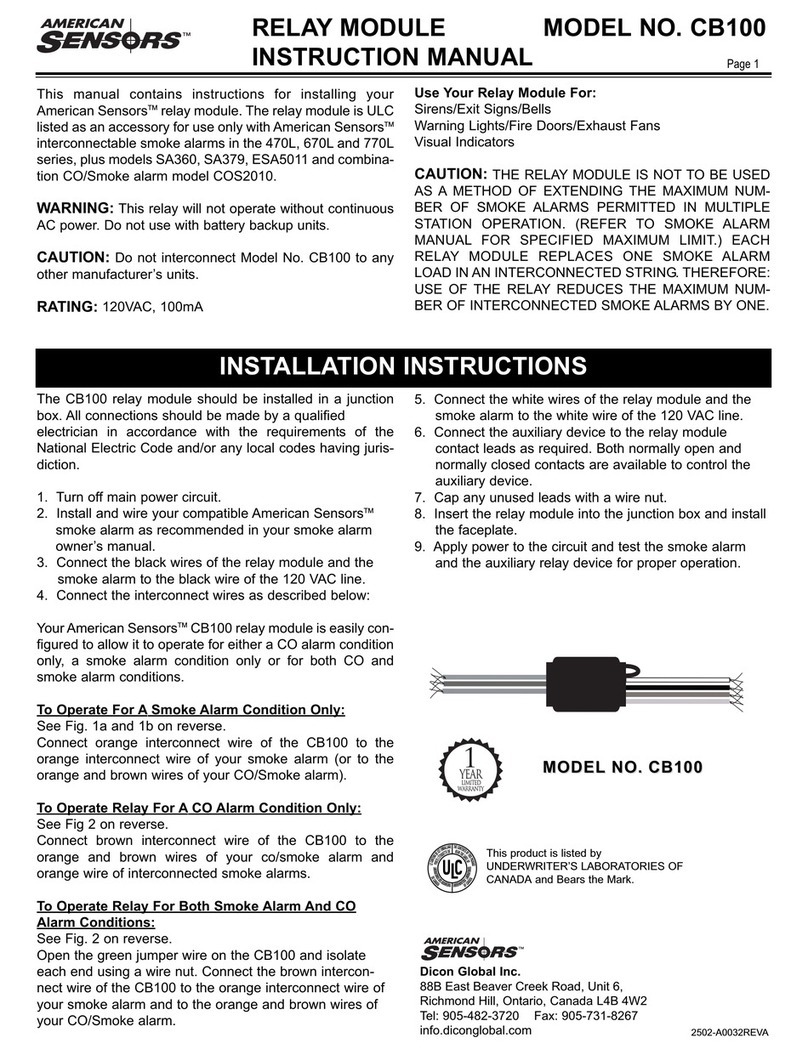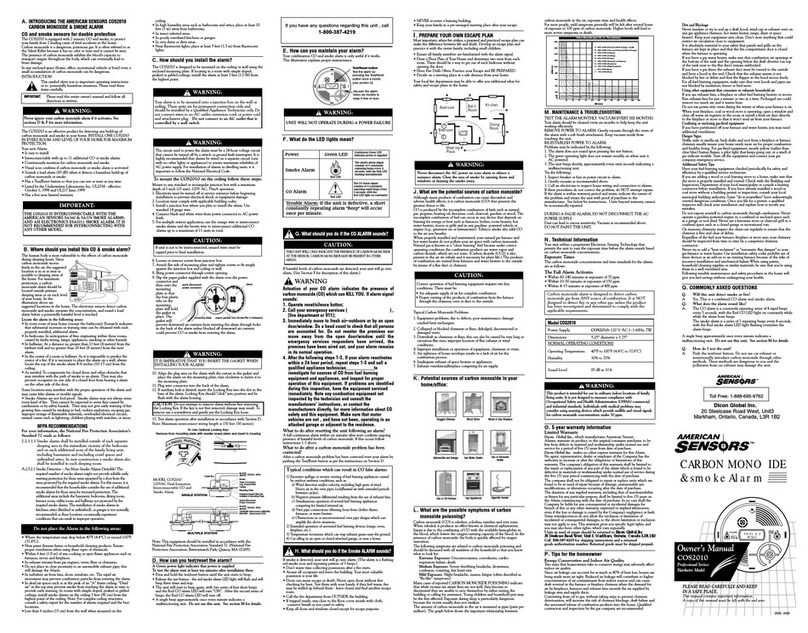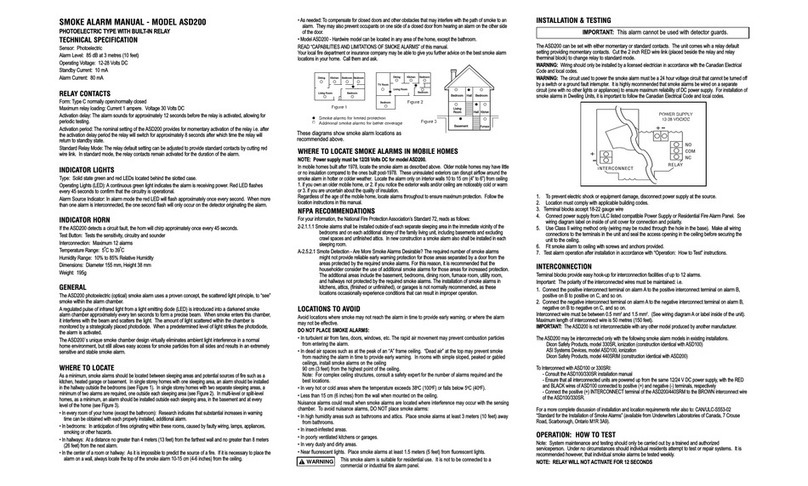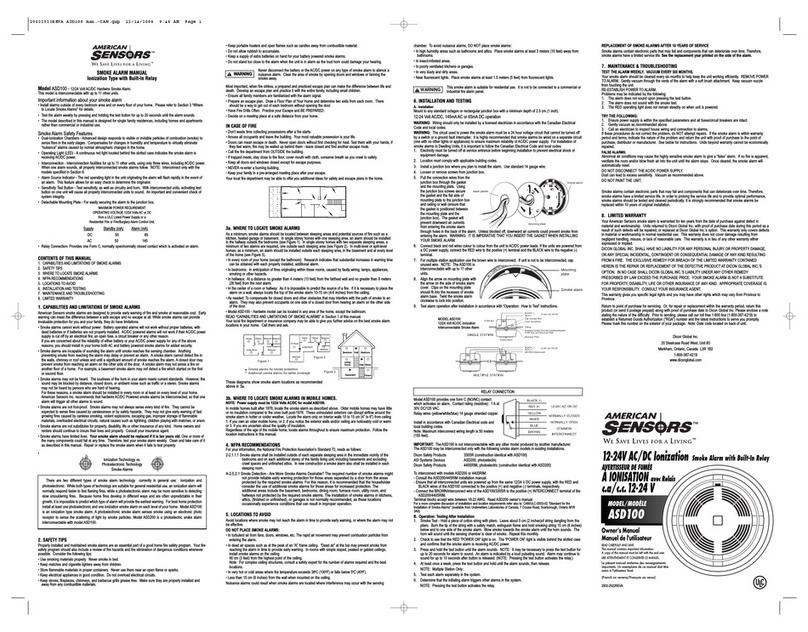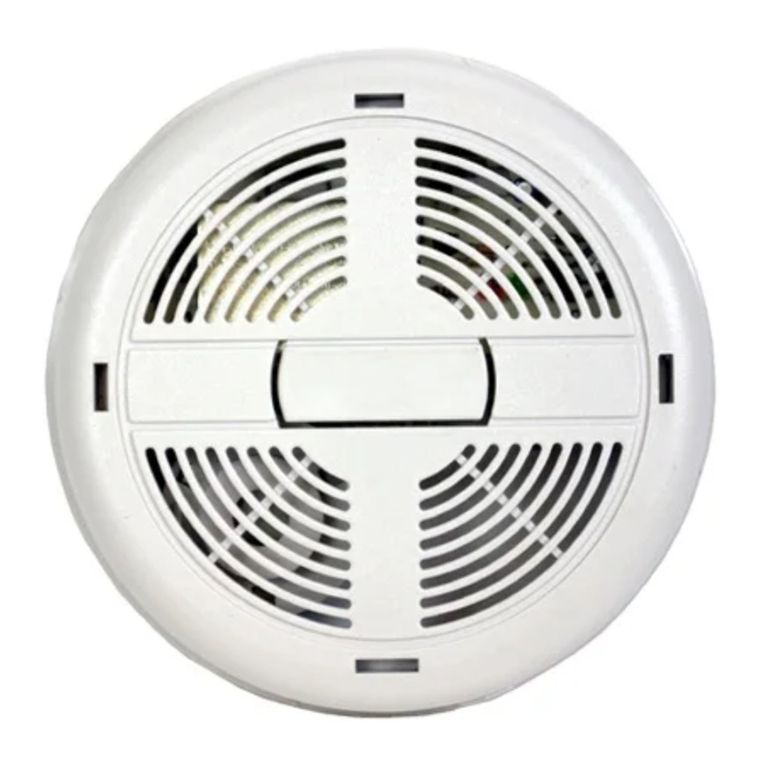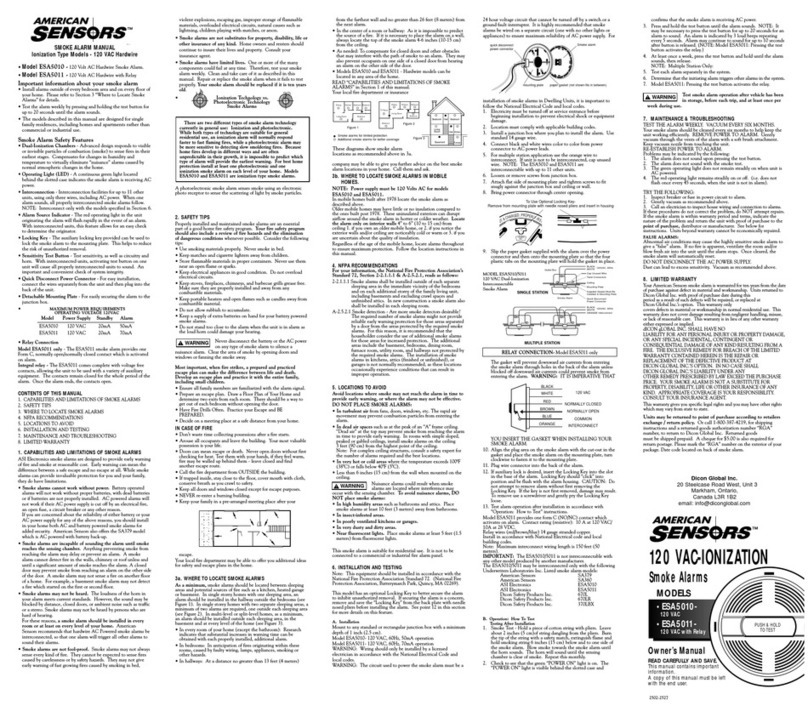SMOKE ALARM MANUAL
Ionization Type Model - 120 VAC Hardwire
€Model SA360 - Professional Multi-Location Model 120 Volt
A C Hardwire Smoke A larm. T his model is interconnectable with
upto 11 other units.
Important information about your smoke alarm
€ Install alarms outside of every bedroom area and on every floor of
your home. Please refer to Section 3 •W here to Locate Smoke
AlarmsŽfor details.
€ Test the alarm weekly by pressingand holdingthetest button for
up to 20 seconds until the alarm sounds.
€
The model describedin thismanual is designedfor single
family residences, including homes and apartments rather than
commercial or industrial use.
Smoke Alarm Safety Features
€ Dual-Ionization Chambers - A dvanced design responds to visible
or invisible particles of combustion (smoke) to sense fires in their
earliest stages. C ompensates for changes in humidity and
temperature to virtually eliminate •nuisanceŽalarms caused by
normal atmospheric changes in the home.
€OperatingLight (LED) - A continuous green light located behind
the slotted case indicates the smoke alarm is receiving AC power.
€ Interconnection - Interconnection facilities for up to 11 other
units, usingonly three wires, including AC power. W hen one
alarm sounds, all properly interconnected smoke alarms follow.
NOT E: Interconnect only with the models specified in Section 6.
€ Alarm Source Indicator - The red operatinglight in the unit
originatingthealarmwill flash rapidly in the event ofan alarm.
With interconnected units, this feature allows for an easycheck to
determine the originator.
€Locking Key - T he auxiliary locking key provided can be used to
lock the smoke alarm to the mountingplate. T his helps to reduce
the risk of unauthorized removal.
€ Sensitivity Test Button - Test sensitivity, as well as circuitry and
horn. With interconnectedunits, activatingtest button on one
unit will cause all properly interconnected units to sound. A n
important and convenient check of system integrity.
€ Quick Disconnect Power Connector - For easy installation,
connect the wires separately from the unit and then pluginto the
back of the unit.
€ Detachable Mounting Plate - For easily securing the alarm to the
junction box.
CONTENTS OF THIS MANUAL
1. CA PABILIT IES AND LIMITATIONS OF SMOKE ALA RMS
2. SA FETY TIPS
3. WHERE TO LOCATE SMOKE ALARMS
4. NFPA RECOMMENDATIONS
5. LOCATIONS TO AVOID
6. INSTALLATION AND TEST ING
7. MAINTENANCE AND TROUBLESHOOT ING
8. LIMIT ED WARRANTY
9. OTHER AMERICAN SENSORS PRODUCTS
1. CAPABILITIES ANDLIMITATIONS OF SMOKE ALARMS
A merican Sensors smoke alarmsare designed to provide early
warning of fire and smoke at reasonable cost. Early warning can
mean the difference between a safe escape and no escape at all.
W hile smoke alarmscan provide invaluable protection for you and
your family, they do have limitations.
€ Smokealarms cannot work without power. Battery operated
alarms will not work without proper batteries, with deadbatteries
or if batteries are not properly installed. A C powered alarms will
not work if their AC power supply iscut off by an electrical fire,
an open fuse, a circuit breaker or any other reason.
If you are concerned about the reliability of either batteries or your
A C power supply for any of the above reasons, you should install
in your homeboth AC and battery poweredsmoke alarms for
added security. A merican Sensors also offers the SA 379 model
which is A C powered with battery back-up.
€ Smoke alarms are incapable of sounding the alarm until smoke
reaches the sensingchamber. A nything preventing smoke from
reaching the alarm may delay or prevent an alarm. A smoke alarm
cannot detect fire in the walls, chimney or roof unless and until a
significant amount of smoke reaches the alarm. A closed door may
prevent smoke from reaching an alarm on the other side of the
door. A smoke alarm may not sense a fire on another floor of a
home. For example, a basement smoke alarmmay not detect a fire
which started on the first or second floor.
€ Smoke alarms may not be heard. T he loudness of the horn in
your alarmmeetscurrent standards. However, the sound maybe
blocked by distance, closed doors, or ambient noise such as traffic
or a stereo. Smoke alarms may not be heard by persons who are
hardof hearing.
For these reasons, a smoke alarm should be installed in every
room or at least on every level of your home. American Sensors
recommends that hardwire A C Powered smoke alarms be
interconnected, so that onealarmwill trigger all other alarms to
soundtheir alarms.
€ Smoke alarms are not fool-proof. Smoke alarms may not always
sense every kind of fire. They cannot be expected to sense fires
caused by carelessness or by safety hazards. T hey may not give
early warning of fast growing fires caused by smoking in bed,
violent explosions, escaping gas, improper storage of flammable
materials, overloaded electrical circuits, natural causes such as
lightning, children playingwith matches, or arson.
€ Smokealarms are not substitutes for property, disability, life or
other insurance of any kind. Home owners and renters should
continue to insure their lives and property. Consult your insurance
agent.
€ Smoke alarms have limited lives. One or more of the many
componentscouldfail at anytime. Therefore, test your smoke
alarm weekly. C lean and take care of it as describedin this
manual. Repair or replacethe smokealarmwhen it fails totest
properly. Your smoke alarm should be replaced if it is ten years
old.
€
A photoelectronic smoke alarm senses smoke using an electronic
photo receptor to sense the scattering of light by smoke particles.
2. SAFETY TIPS
Properly installed and maintained smoke alarms are an essential part
of a goodhome fire safety program. Your fire safety program should
also include a review of fire hazards and the elimination of
dangerous conditions whenever possible. Consider the following tips:
€ Use smoking materials properly. N ever smoke in bed.
€ Keep matches and cigarette lighters away from children.
€ Store flammable materials in proper containers. Never use them
near an open flame or sparks.
€ Keep electrical appliances in good condition. Do not overload
electrical circuits.
€ Keep stoves, fireplaces, chimneys, andbarbecue grills grease free.
Make sure they are properly installed and away from any
combustible materials.
€ Keep portable heaters and open flames such as candles away from
combustible material.
€ Do not allow rubbish to accumulate.
€ Keep a supply of extra batteries on hand for your battery powered
smoke alarms.
€ Do not stand too close to the alarm when the unit is in alarm as the
loud horn could damage your hearing.
Never disconnect the battery or the A C power on any type of smoke
alarm to silence a nuisance alarm. C lear the area of smoke by opening
doors and windows or fanning the smoke away.
Most important, when fire strikes, a prepared
and practiced escape plan can make the difference between life and
death. Develop an escape plan and practice it with the entire family,
includingsmall children.
€ Ensure all family members are familiarized with the alarm signal.
€ Prepare an escape plan. Draw a Floor Plan of Your Home and
determine two exits from each room. T here should be a way to get
out of each bedroom without opening the door.
€ Have Fire Drills Often. Practice your Escape and BE PR EPAR ED.
€ Decide on a meeting place at a safe distance from your home.
IN CASE OF FIRE
€ Don•t waste time collecting possessions after a fire starts.
€ A rouse all occupants and leave the building. Your most valuable
possession is your life.
€ Doorscan mean escapeor death. Never open doors without first
checkingfor heat. Test them with your hands, if they feel warm, fire
may be walled upbehind them - leave closed and find another
escape route.
€ Call the fire department from OUTSIDE the building.
€ If trapped inside, stay close to the floor, cover mouth with cloth,
conserve breath as you crawl to safety.
€ Keep all doors and windows closed except for escape purposes.
€ NEV ER re-enter a burning building.
€ Keep your family in a pre-arranged meetingplaceafter your escape.
Your local fire department may be able to offer you additional ideas
for safety and escape plans in the home.
3a. WHERE TO LOCATE SMOKE ALARMS
As a minimum, smoke alarms should be located between sleeping
areas and potential sources of fire such as a kitchen, heated garage or
basement. In single storeyhomeswith onesleepingarea, an alarm
should be installed in the hallway outside the bedrooms (see Figure
1). In single storey homes with two separate sleepingareas, a
minimum of two alarms are required, one outside each sleeping area
(see Figure 2). In multi-level or split-level homes, as a minimum, an
alarm should be installed outside each sleeping area, in the basement
and at every level of the home (see Figure 3).
€ In every room of your home ( except the bathroom): R esearch
indicates that substantial increases in warning time can be obtained
with each properly installed, additional alarm.
€ In bedrooms: In anticipation of firesoriginatingwithin these rooms,
caused by faulty wiring, lamps, appliances, smoking or other hazards.
€ In hallways: At a distance nogreater than 13 feet (4 meters) from
the farthest wall andno greater than 26 feet (8 meters) fromthe
next alarm.
€ In the center of a room or hallway: A s it is impossible to predict the
sourceofa fire. If it is necessary toplacethe alarm on a wall, always
locate the top of the smoke alarm 4-6 inches (10-15 cm) from the
ceiling.
€ A s needed: To compensate for closed doors and other obstacles that
may interfere with the path of smoke to an alarm. T hey may also
prevent occupants on one side of a closed door from hearing a alarm
on the other side of the door.
€ Model SA360 - Professional Multi-Locationmodel can be located
in any area of the home.
READ •CAPABILITIES AND LIMITATIONS OF SMOKE
ALA RMSŽin Section 1of thismanual.
Your local fire department or insurance company may be able to give
you further advice on the best smoke alarm locations in your home.
Call them and ask.
T here are two different types of smoke alarm technology
currently in general use: ionization and photoelectronic. W hile
both types of technology are suitable for general residential use,
an ionization alarm will normally respond faster to fast flaming
fires, while a photoelectronic alarm may be more sensitive to
detecting slow smoldering fires. B ecause home fires develop in
different ways and are often unpredictable in their growth, it is
impossible topredict which type of alarm will providetheearliest
warning. For best home protection install at least one
photoelectronic and one ionization smoke alarm on each level of
your home. Model SA 360 is an ionization typesmoke alarm.
Ionization Technology vs.
Photoelectronic Technology
Smoke A larms
3b. WHERE TO LOCATE SMOKE ALARMS IN MOBILE HOMES
N OT E: Power supply must be 120 Volts AC for model SA 360.
In mobile homes built after 1978 locate the smoke alarm as
describedabove.
Older mobile homes may have little or no insulation compared to
the onesbuilt post 1978. Theseuninsulated exteriorscan disrupt
airflowaround the smoke alarmin hotter or colder weather. Locate
the alarm only on interior walls 4Žto 6Ž (10 to 15 cm) from ceiling
1. if you own an older mobile home or 2. if you notice the exterior
walls and/or ceiling are noticeably cold or warm or 3. if you are
uncertain about the quality of insulation.
Regardless of the age of the mobile home, locate alarms throughout
to ensure maximum protection. Follow the location instructions in
this manual.
4. NFPA RECOMMENDATIONS
For your information, the National Fire Protection Association•s
Standard 72 reads as follows:
2-2.1.1.1
Smoke alarms shall be installed outside of each separate sleeping
area in the immediate vicinity of the bedrooms and on each
additional storey of the family living unit, including basements and
excluding crawl spaces and unfinished attics. I n new construction a
smoke alarm also shall be installed in each sleeping room.
A-2.5.2.1 Smoke Detection- Are More Smoke Alarms Desirable? The
requirednumber of smoke alarms might not provide reliable early
warning protection for those areas separated by a door fromthe
areas protected by therequiredsmoke alarms. For this reason, it is
recommended that thehouseholder consider the use of additional
smoke alarms for those areas for increased protection. The
additional areasincludethebasement, bedrooms, diningroom,
furnace room, utility room, and hallways not protectedby the
requiredsmokealarms. T he installation of smoke alarms in
kitchens, attics (finishedor unfinished), or garages is not
normally recommended, as these locationsoccasionally
experience conditions that can result in improper operation.
5. LOCATIONS TOAVOID
Avoid locations where smoke may not reach the alarm in time to
provide early warning, or where the alarm may not be effective.
DO NOT PLACE SMOKE ALAR MS:
€ In turbulent air from fans, doors, windows, etc. Therapidair
movement may prevent combustion particles from entering the
alarm.
€ I n dead air spaces such as at the peak of an • AŽframe ceiling.
•Dead airŽ at the topmay prevent smoke from reachingthe alarm
in time to provide early warning. In rooms with simple sloped,
peaked or gabled ceilings, install smoke alarms on the ceiling
3 feet (90 cm) fromthe highest point of the ceiling.
Note: For complex ceilingstructures, consult a safety expert for
the number of alarms required and the best locations.
€ I n very hot or cold areas where the temperature exceeds 1000F
(380C) or falls below400F (50C).
€ Less than 6 inches (15 cm) from thewall when mountedon the
ceiling.
Nuisance alarms could result when smoke alarms are located where
interference may occur with the sensing chamber. T o avoid nuisance
alarms, DO N OT place smoke alarms:
€ In high humidity areas such as bathrooms and attics. Place smoke
alarms at least 10feet (3 meters) away frombathrooms.
€ I n insect-infested areas.
€ I n poorly ventilated kitchens or garages.
€ I n very dusty and dirty areas.
€ N ear fluorescent lights. Place smoke alarms at least 5 feet
(1.5 meters) from fluorescent lights.
T his smoke alarm is suitable for residential
use. It is not to be connected to a commercial
or industrial fire alarm panel.
6. INSTALLATION AND TESTING
T his model has an optional Locking Key to better secure the alarm
to inhibit unauthorized removal. If securing the alarm is a concern,
remove and save the •Locking KeyŽfrom the back plate with needle
nosed pliers before installing the alarm. See point 12 in this section
for more details on this feature.
A. Installation
Mount to any standard or rectangular junction box with a minimum
depth of 1 inch (2.5 cm). 120V AC, 55mA operation.
WA RNIN G: Wiring should only be installed by a licensed
electrician in accordance with the National Electrical Codeand
local codes.
WA RNIN G: T he circuit used to power the smoke alarm must be a
24 hour voltage circuit that cannot beturned off by a switch or a
ground fault interrupter. I t is highly recommended that smoke alarms
be wired on a separate circuit ( one with no other lights or
appliances) to ensure maximum reliability of A C power supply. For
installation of smoke alarms in Dwelling Units, it is important to
follow the National Electrical C ode and local codes.
1. Electricity must be turned off at service entrance before
beginning installation to prevent electrical shock or equipment
damage.
2. Location must comply with applicable building codes.
3. Install a junction box where you plan to install the alarm. U se
standard 14 gauge wire.
4. Connect black and white wires color to color from power
connector toAC power leads.
5. For multiple station application use the orange wire to
interconnect. If unit is not to be interconnected, cap unused
wire. NOT E: T he SA 360 is interconnectable with up to 11
other units.
6. Loosen or remove screws from junction box.
7. A ttach flat side of mounting plate and tighten screws to fit
snugly against the junction box and ceiling or wall.
8. Bringpower connector through center opening.
9. Slip the paper gasket supplied with the alarm over the power
connector and then onto the mounting plate so that the four
plastic tabs on the mounting plate will hold the gasket in place.
T he gasket will prevent downward air currents from entering the
smoke alarm through holes in the back of the alarm, unless
blocked off, downward air currents could prevent smoke from
enteringthe alarm. WARNI NG: IT IS IMPERATIVE THAT
YOU INSERT T HE GASKET WHEN INSTA LLING YOUR
SMOKE ALA RM.
10. Align theplugarea on thesmokealarmwith thecutout in the
gasket and place the smoke alarm on the mounting plate, turn
clockwise to fasten it to the mounting plate.
11. Plugwire connector into the back of the alarm.
12. If auxiliary lock is desired, insert the Locking Key into the slot
in the base of the alarm. Locking Key should •clickŽinto
position andbe flush with the alarmhousing. CAUTION: Do
not attempt to remove alarmwithout first removingthe Locking
Key. If the key is not first removed, damage may result. To
remove, use a screwdriver and gently pry theLockingKey loose.
13. Test alarmoperation after installation in accordance with
•Operation: How to TestŽ instructions.
Note: Maximum interconnect wiring length is 150 feet (50 meters).
IMPORTANT: T he SA 360 is not interconnectable with any other
model produced by another manufacturer. T he SA 360 may be
interconnected only with the following Underwriters• Laboratories
Inc. listed smoke alarm models:
American Sensors SA 379
American Sensors SA 360
A SI Electronics (A merican Sensors) ESA 5010/ESA 5011
Dicon Safety Products Inc. 670L/LR
Dicon Safety Products Inc. 370LBX
Note: T his equipment should be installed in accordance with the
National Fire Protection Association Standard 72. (National Fire
Protection A ssociation, Batterymarch Park, Quincy, MA 02269).
B. Testing After Installation
1. Check to see that the green •POWER ONŽlight is on. T he
•POW ER ON Žlight is visible behind the slottedcase and
confirms that the smoke alarm is receiving A C power.
2. Press and hold the test button until the alarm sounds. N OT E: It
may be necessary to press the test button for up to 20 seconds for
an alarmto sound. An alarmis indicated by 3 loudbeeps
repeatingevery 5 seconds. A larm may continue tosoundfor up
to 10 seconds after button is released.
3. At least once a week, pressthe test button and holduntil the
alarm sounds, then release.
NOT E: Multiple Station Only:
4. Test each alarm separately in the system.
5. Determine that the initiating alarm triggers other alarms in the
system.
7. MAINTENANCE & TROUBLESHOOTING
TEST THE ALA RM WEEKLY. VACUUM EVERY SIX MONTHS.
Your smoke alarm should be cleaned every six months to help keep
the unit working efficiently. REMOV E POW ER T O A LA RM.
Gently vacuum through the vents of the alarm with a soft brush
attachment. K eep vacuum nozzle from touching the unit.
RE-ESTABLISH POWER T O ALARM.
Problems may beindicated by the following:
1. T he alarm doesnot sound upon pressing the test button.
2. Thegreen operatinglight does not remain steadily on when unit
is A C powered.
3. T he red operating light remains steadily on or off. ( i.e. does not
flash once every 45seconds, when the unit is not in alarm).
Try the following:
1. Inspect breaker or fuse in power circuit to alarm.
2. Gently vacuum as recommended above.
3. Call an electrician toinspect house wiringand connection to
alarms.
If these procedures do not correct the problem, do NOT attempt
repairs. If the smoke alarm is within warranty period and terms,
indicate the nature of the problem and return the unit with proof of
purchase to the point of purchase, distributor or manufacturer. See
below for instructions. Units beyond warranty cannot be
economically repaired.
FA LSE A LARMS:
A bnormal air conditionsmay cause the highly sensitive smoke alarm
to give a •falseŽ alarm. If no fire is apparent, ventilate the room
and/or blow fresh air into the unit until the alarm stops. Once
cleared, the smoke alarm will automatically reset.
DO NOT DISCONNECT THE AC POWER SUPPLY.
Dust can lead to excess sensitivity. Vacuum as recommended above.
DO NOT PAINT THE UNIT.
8. LIMITED WARRANTY
Your American SensorsSA 360 smoke alarmis warranted for ten
years from the date of purchase against defect in material and
workmanship. U nits returned to Dicon G lobal Inc.
with proof of purchase date duringthis period as a result of such
defects will be repaired, or replaced at Dicon Global Inc.s
. •option, without charge. T his warranty only covers defectsin
material or workmanship in normal residential use. Thiswarranty
does not cover damage resulting from negligent handling, misuse, or
lack of reasonable care. This warranty is in lieuof any other
warranty either expressed or implied.
DICON GLOBA L INC. SHALL HAVE NO
LIABILIT Y FOR ANY PERSONAL INJURY OR PROPERT Y
DA MAGE, OR ANY SPECIAL INCIDENTAL, CONTINGENT
OR CONSEQUENTIA L DAMAGE OF A NY KIND RESULT ING
FROM A FIRE. THE EXCLUSIVE REMEDY FOR BREA CH OF
THE LIMITED WARRA NTY CONTA INED HEREIN IS T HE
REPAIR OR REPLA CEMENT OF T HE DEFECT IVE PRODUCT
AT DICON GLOBAL INC.S OPT ION IN NO
CA SE SHALL DICON GLOBA L INC.S
LIABILIT Y UNDER A NY OTHER REMEDY PRESCRIBED BY
120 VAC -IONIZA TION
SMOKE ALARM
READ CAREFULLY AND SAVE .
T his manual contains important information.
A copy of this manual must be left withthe end user.
2502-2509 (REV-1)
LAW EXCEED T HE PURCHASE PRICE. YOUR SMOKE
ALA RM IS NOT A SUBST ITUTE FOR PROPERTY,
DISABILIT Y, LIFE OR OT HER INSURANCE OF ANY KIND.
APPROPRIATE COVERAGE IS YOUR RESPONSIBILIT Y.
CONSULT YOUR INSURANCE AGENT.
T his warranty gives you specific legal rights and you may have other
rights which may vary from state to state.
U nits may be returned to point of purchase according to
retailers exchange / return policy. Or call 1-800-387-4219, for
shipping instructions and a returned goods authorization number
•RGA Žnumber, to return to Dicon Global Inc.
Returned goods must be shipped prepaid. A cheque for $5.00 is
also required for return postage
. Please mark the •RGA Žnumber
on the exterior of your package. Date code located on back of smoke
alarm.
Dicon Global Inc.
20 Steelcase Road, Unit 3
Markham, Ontario,
Canada L3R 1B2
9. AMERICAN SENSORS PRODUCTS
A merican Sensors offers a complete line of smoke alarms. Select
from this group of quality products to ensure your home is fully
protected in case of fire.
WAR NING
!
Smoke alarm
paper gasket (not s hown-fits in between)
mounting plate
quick disconnect
power connector
BLAC K 120VAC, 60Hz
WHITE
Cap Unused Wire
Twis t Conne ctors
Ceiling
Mounting Pla te
S upplied Ga sket M ust B e
Installed In Mounting P late
Quick Disconnect
P ower C onnector
BLAC K 120VAC, 60Hz
WHITE
OR ANGE Interconnect
MODEL SA360
120VAC Dual-Ionization
Interconnectable
Smoke A larm
MULTIPLE S TATION
Smoke Alarm
Outlet B ox
SINGLE S TATION
MODEL
SA360
To Use Optional Locking Key-
Remove from mounting plate with needle nosed pliers and insert in housing
